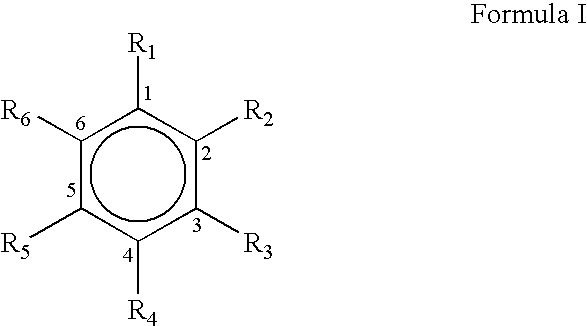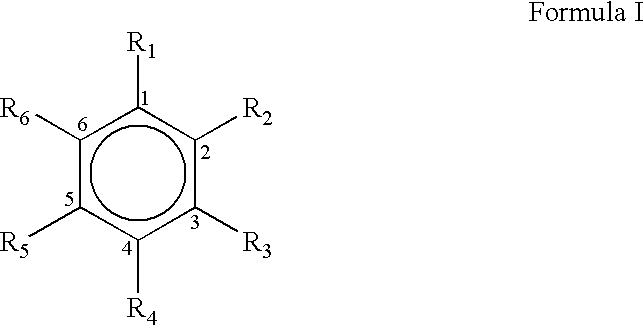Process for the preparation of substituted trans-cinnamaldehyde, a natural yellow dye, from phenylpropane derivatives
a technology of phenylpropane and substituted cinnamaldehyde, which is applied in the preparation of carbonyl compounds, carbonyl compound preparations, organic chemistry, etc., can solve the problems of reaction mixtures, one or more process deficiencies, and limited percentage of substituted cinnamaldehydes in the plant kingdom, etc., to achieve high yield
- Summary
- Abstract
- Description
- Claims
- Application Information
AI Technical Summary
Benefits of technology
Problems solved by technology
Method used
Image
Examples
example i
Synthesis of 2,4,5-Trimethoxycinnamaldehyde From 2,4,5-Trimethoxyphenylpropane (by Thermal Method)
A solution of 2,4,5-Trimethoxyphenylpropane (5 g) in 70 mL of dry dioxane was placed in 100 ml round bottom flask. To this was added a catalytic amount of acetic acid (2-4 drops) and 16 g of DDQ and finally started refluxing the mixture at 50 to 140.degree. C. for 5 to 9 hrs. The solution, which was initially deep green, turned into pale yellow with the formation of hydroquinone (DDQH.sub.2). The mixture was cooled and the solid DDQH.sub.2 was filtered and further washed with chloroform. The filtrate and washings were combined and evaporated under reduced pressure. The product was taken in ether (80 ml) and the ether layer was washed with aqueous NaOH (15%, 2.times.15 ml). The combined aqueous layers are further extracted with ether (3.times.15 ml). The ether layers were combined and washed with saturated sodium chloride (3.times.15 ml), dried over anhydrous sodium sulphate and filtered...
example ii
Permanganate Oxidation of the 2,4,5-Trimethoxycinnamaldehyde Into 2,4,5-Trimethoxybenzaldehyde
A solution of the 2,4,5-Trimethoxycinnamaldehyde (0.5 g) was treated with KMnO.sub.4 (0.5 g) in dry acetone (20 ml). The reaction mixture was left at room temperature for 24 hr, manganese dioxide was filtered off and the solvent was removed. The residue was dissolved in ethyl acetate and washed carefully with 10% NaHCO.sub.3, brine, and dried over anhydrous Na.sub.2 SO.sub.4. Evaporation of the solvent afforded a crude solid, which was further recrystallised from water to afford 0.2 g 2,4,5-trimethoxybenzaldehyde as a colorless solid, mp 114.degree. C. (lit. mp 114.degree. C.); IR (film) .nu.max 1662 (carbonyl group), 1620, 1518, 1481, 1419, 1361, 1300, 1278, 1222, 1199, 1138, 1025, 865 cm.sup.-1 ; .sup.1 H NMR .delta. 10.32 (1H, s, CHO), 7.33 (1H, s, 6H), 6.50 (1H, s, 3H), 3.98 (3H, s, 2-OCH.sub.3), 3.93 ((3H, s, 4-OCH.sub.3), 3.88 (3H, s, 5-OCH.sub.3); .sup.13 C NMR .delta. 187.96 (CHO), ...
example iii
Synthesis of 2,4,5-Trimethoxycinnamaldehyde From .beta.-Asarone (by Thermal Method)
A mixture of .beta.-asarone (1.87 g), selenium dioxide (0.90 g) and dioxane (30 ml) containing 0.3 ml of water was refluxed for 6 h. Additional selenium dioxide (0.21 g) was added to the mixture, and the mixture was refluxed for further 12 h. The mixture was cooled and filtered to remove the precipitated black selenium. The filtrate was evaporated under reduced pressure and the resulting residue was redissolved in CH.sub.2 Cl.sub.2, washed with brine, and dried over anhydrous Na.sub.2 SO.sub.4. Evaporation of the solvent afforded a mixture of 2,4,5-trimethoxycinnamaldehyde and corresponding alcohol (as formation of side product alcohol is common with aldehyde during the allylic oxidation of several analogs of .beta.-asarone with SeO.sub.2) which was directly treated with excess of pyridinium chlorochromate (1 g) in dry CH.sub.2 Cl.sub.2 (50 ml). After being stirred at room temperature for overnight, t...
PUM
| Property | Measurement | Unit |
|---|---|---|
| temperature | aaaaa | aaaaa |
| temperature | aaaaa | aaaaa |
| mole ratio | aaaaa | aaaaa |
Abstract
Description
Claims
Application Information
 Login to View More
Login to View More - R&D
- Intellectual Property
- Life Sciences
- Materials
- Tech Scout
- Unparalleled Data Quality
- Higher Quality Content
- 60% Fewer Hallucinations
Browse by: Latest US Patents, China's latest patents, Technical Efficacy Thesaurus, Application Domain, Technology Topic, Popular Technical Reports.
© 2025 PatSnap. All rights reserved.Legal|Privacy policy|Modern Slavery Act Transparency Statement|Sitemap|About US| Contact US: help@patsnap.com



